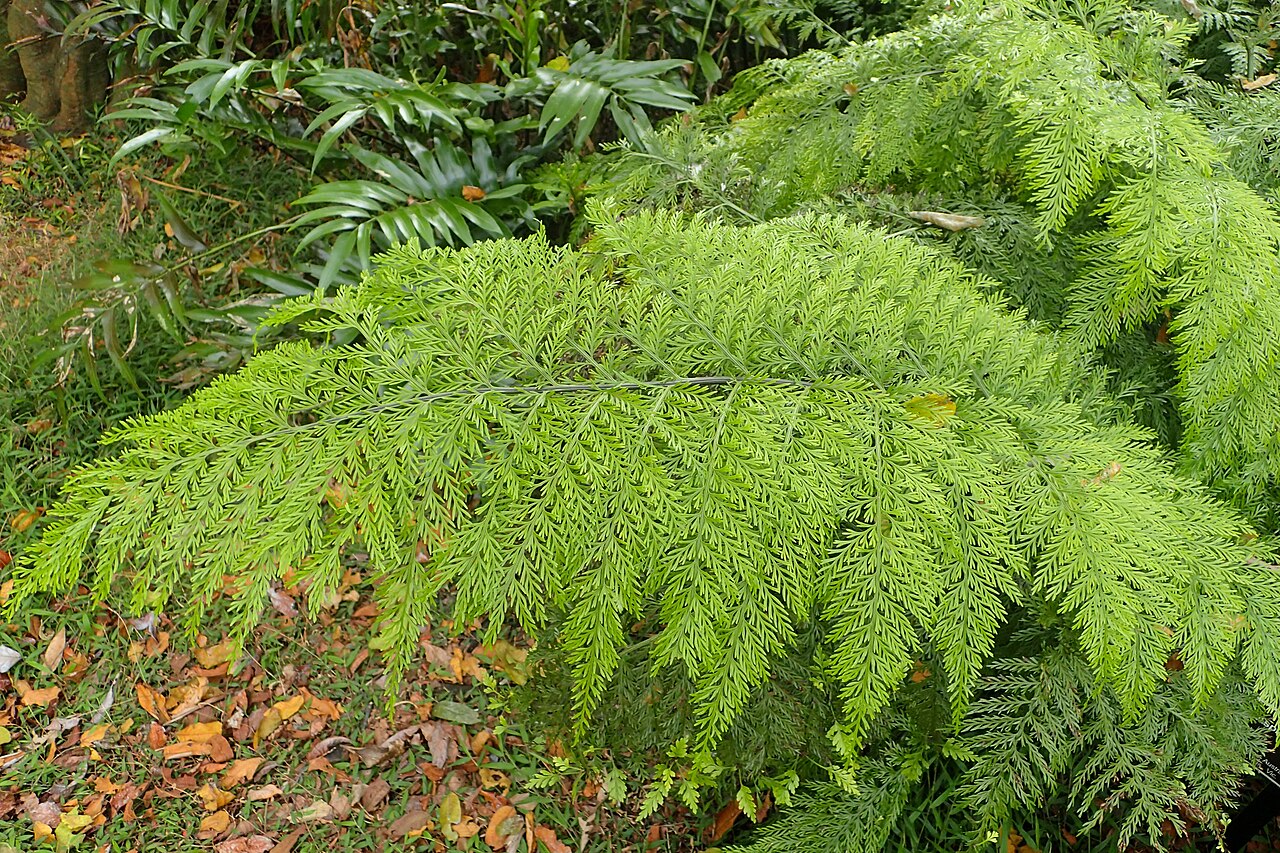Crown Fern (Piupiu)
Blechnum discolor
Blechnum discolor, commonly known as Crown Fern or Piupiu in te reo Māori, is a distinctive and attractive native fern of New Zealand. It forms a striking crown of arching fronds that emerge from a central point, creating a fountain-like appearance. With its elegant form and adaptability to shaded environments, Crown Fern is both an important component of native forest understories and a species of notable ecological significance in New Zealand's forest ecosystems.

Image credit: Wikipedia
Quick Facts
| Height | 0.5-1 meter |
|---|---|
| Water Needs | Moderate to high |
| Light | Shade to partial shade |
| Frost Tolerance | Moderate |
| Growth Rate | Slow to moderate |
| Lifespan | Long-lived perennial |
Climate Best Suited To
Crown Fern is native to the forests of New Zealand, where it thrives in cool, moist, shaded environments. It is found throughout the country in suitable habitats, particularly in damp gullies and forest understories. It prefers areas with consistent moisture and protection from direct sunlight and drying winds.
Regional Suitability
| City | Climate Suitability |
|---|---|
| Whangārei | Moderate |
| Auckland | Moderate |
| Hamilton | Ideal |
| Tauranga | Moderate |
| Rotorua | Ideal |
| Gisborne | Moderate |
| New Plymouth | Ideal |
| Napier | Challenging |
| Whanganui | Moderate |
| Palmerston North | Ideal |
| Wellington | Ideal |
| Nelson | Ideal |
| Christchurch | Moderate |
| Dunedin | Ideal |
| Invercargill | Ideal |
Growing Requirements
Soil Requirements
Crown Fern performs best in the following soil conditions:
- Rich, humus-filled soil
- Good moisture retention
- Well-draining but consistently damp
- Slightly acidic to neutral pH (5.5-7.0)
- Benefits from added leaf mold or composted pine needles
- Tolerates poor soils if moisture is adequate
Light Requirements
This fern prefers shaded conditions:
- Deep to dappled shade
- Protection from direct sunlight, especially midday sun
- Morning sun tolerated in cooler regions
- Ideal under canopy of trees or larger shrubs
- Can tolerate more light if soil remains consistently moist
- Avoid hot, exposed sites
Water Requirements
Consistent moisture is key for Crown Fern:
- Regular watering to maintain even soil moisture
- Never allow soil to dry out completely
- Reduce frequency in winter but don't let soil dry out
- Benefits from misting in dry conditions
- Mulch to help retain soil moisture
- Good drainage to prevent waterlogging
Temperature Tolerance
Crown Fern has the following temperature preferences:
- Prefers cool to moderate temperatures
- Ideal growing range: 10-24°C (50-75°F)
- Can tolerate light frosts once established
- Protect from severe frost in colder regions
- Dislikes hot, dry conditions
- Provide extra humidity during hot periods
Crown Fern's ecological significance is evident in its role as a key understory species. Its presence indicates a healthy forest ecosystem, and its growth requirements reflect its ecological significance in maintaining forest moisture levels and providing habitat for small forest creatures.
Uses & Significance
Garden Uses
- Shaded woodland gardens
- Native ferneries
- Understory planting
- Natural areas
- Container growing in shade
Cultural Significance
- Traditional Māori uses for bedding
- Seasonal indicator plant
- Part of forest ecosystem
- Historical fern collection specimen
Ecological Value
- Forest understory species
- Habitat for invertebrates
- Soil stabilization
- Moisture retention in forest floor
- Indicator of forest health
Seasonal Care Calendar
Spring
- Remove any winter-damaged fronds
- Apply slow-release fertilizer if needed
- Divide overgrown clumps
- Plant new specimens
- Monitor for pests
- Ensure adequate moisture as growth resumes
Summer
- Water regularly during dry periods
- Mist fronds in hot weather
- Monitor for signs of heat stress
- Remove any damaged or yellowing fronds
- Maintain mulch layer
Autumn
- Ideal time for planting
- Clean up fallen debris
- Apply fresh mulch
- Reduce watering as temperatures cool
- Monitor for slug damage
Winter
- Minimal care needed
- Protect from severe frost
- Remove damaged fronds
- Maintain consistent moisture
- Plan for spring division if needed
When to Prune and How Much
Crown Fern requires minimal pruning but benefits from regular maintenance:
- Remove dead, damaged, or yellowing fronds at any time
- Cut old fronds back to the base in late winter/early spring
- Use clean, sharp tools to prevent disease spread
- Avoid cutting new fronds that are still unfurling
- Remove any unwanted plantlets that appear
Note: Always sterilize pruning tools between plants to prevent the spread of disease. Make clean cuts close to the base of the frond to maintain plant health and appearance.
Planting Guide
When to Plant
The best time to plant Crown Fern is during autumn or spring when temperatures are mild and rainfall is more reliable. This gives the plant time to establish before extreme weather conditions.
Site Selection
Choose a location that mimics the fern's natural habitat:
- Shaded woodland gardens or ferneries
- Under the canopy of trees or large shrubs
- North-facing slopes (in Southern Hemisphere)
- Protected gullies or alongside streams
- Areas protected from strong winds
- Avoid hot, exposed sites
Planting Steps
- Prepare the planting area by incorporating plenty of organic matter
- Dig a hole twice as wide as the root ball
- Position the plant so the crown is level with the soil surface
- Backfill with soil, firming gently
- Water thoroughly after planting
- Apply a layer of mulch, keeping it away from the crown
Initial Care
Water regularly during the first growing season, especially during dry periods. Protect from strong winds and direct sun until established.
Propagation Methods
Division
The most reliable method for home gardeners:
- Divide established plants in early spring or autumn
- Carefully dig up the entire plant
- Use a sharp knife or spade to separate the crown into sections
- Ensure each division has both roots and fronds
- Replant divisions immediately at the same depth as before
- Water thoroughly and keep consistently moist until established
- Protect new divisions from direct sun and wind
Spores
For those wanting a challenge:
- Collect fertile fronds when spore cases turn brown (usually late summer)
- Place fronds on clean paper in a warm, dry place for 1-2 days
- Collect the fine, dust-like spores that fall onto the paper
- Prepare a sterile growing medium of peat and perlite
- Sprinkle spores thinly over the surface
- Cover with glass or plastic to maintain humidity
- Keep at 18-21°C (65-70°F) in indirect light
- Mist with distilled water to maintain moisture
- Prothalli will form in 1-3 months
- Young ferns will develop in 6-12 months
- Transplant when several fronds have formed
Cultural History
Crown Fern has a place in New Zealand's natural and cultural heritage:
Traditional Māori Uses
- Known as "piupiu" or "petipeti" in te reo Māori
- Fronds sometimes used for bedding material
- Used as a calendar plant, with new growth indicating seasonal changes
- Occasionally used for medicinal purposes
- Provided shelter for ground-dwelling insects that were food sources
Ecological Significance
- Important component of native forest understories
- Provides habitat for small invertebrates
- Contributes to forest floor biodiversity
- Helps prevent soil erosion on forest floors
- Indicator species for healthy forest ecosystems
European Settlement Impact
- Collected by early European botanists
- Habitat reduced through forest clearance
- Included in Victorian-era fern collections
- Specimens sent to European botanical gardens
Contemporary Significance
Today, Crown Fern is valued both for its ecological role in native forests and as an ornamental plant in gardens. Its distinctive crown-like form makes it a popular choice for shaded gardens and native plantings. Conservation efforts include preserving its natural habitat in protected forest areas and using it in restoration projects to rebuild native forest understories.
Pests & Diseases
Common Pests
- Slugs and Snails: Often damage new fronds. Control with organic baits, copper tape, or beer traps.
- Scale Insects: May appear on fronds as small bumps. Remove with cotton swab dipped in alcohol or use horticultural oil.
- Caterpillars: Occasionally feed on fronds. Hand-pick or use organic Bacillus thuringiensis spray if infestation is severe.
- Mealybugs: Sometimes infest the crown and base of fronds. Treat with insecticidal soap or neem oil.
Common Diseases
- Root Rot: Caused by overwatering or poor drainage. Ensure well-draining soil and avoid waterlogged conditions.
- Crown Rot: Often results from water sitting in the crown. Avoid overhead watering and ensure good air circulation.
- Fungal Leaf Spots: Various fungi can cause spotting on fronds. Improve air circulation and avoid overhead watering.
- Rust: Appears as orange or brown spots on fronds. Remove affected fronds and improve air circulation.
Environmental Issues
- Desiccation: Low humidity causes frond edges to brown and curl. Increase humidity with misting or mulching.
- Sunburn: Direct sunlight causes yellowing and browning of fronds. Move to a more shaded location.
- Frost Damage: Severe frosts can damage fronds. Protect with frost cloth during cold snaps.
- Wind Damage: Strong winds can tatter fronds. Plant in sheltered locations or provide windbreaks.
Crown Fern is generally resilient to pests and diseases when grown in appropriate conditions. Good cultural practices including proper spacing, appropriate watering, and good air circulation will prevent most problems. This fern is more susceptible to environmental stress than pest or disease issues, so focus on providing the right growing conditions.
Bonus Tip
Create a stunning visual effect by planting Crown Fern in a circular pattern around the base of a native tree or large shrub. The radiating crowns of the ferns echo the circular pattern, creating a natural mandala effect when viewed from above. This arrangement not only looks beautiful but also mimics the way these ferns naturally grow in forest settings. For added interest, intersperse with native ground covers like Pratia angulata (Panakenake) with its tiny white flowers.



